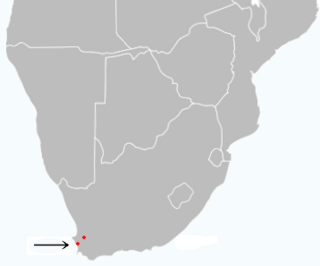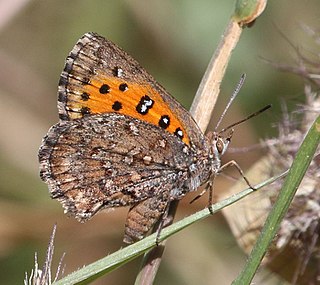
South Africa occupies the southern tip of Africa, its coastline stretching more than 2,850 kilometres from the desert border with Namibia on the Atlantic (western) coast southwards around the tip of Africa and then northeast to the border with Mozambique on the Indian Ocean. The low-lying coastal zone is narrow for much of that distance, soon giving way to a mountainous escarpment that separates the coast from the high inland plateau. In some places, notably the province of KwaZulu-Natal in the east, a greater distance separates the coast from the escarpment. Although most of the country is classified as semi-arid, it has considerable variation in climate as well as topography. The total land area is 1,220,813 km2 (471,359 sq mi). It has the 23rd largest Exclusive Economic Zone of 1,535,538 km2 (592,875 sq mi).

Fynbos is a small belt of natural shrubland or heathland vegetation located in the Western Cape and Eastern Cape provinces of South Africa. This area is predominantly winter rainfall coastal and mountainous areas with a Mediterranean climate. The fynbos ecoregion is within the Mediterranean forests, woodlands, and scrub biome. In fields related to biogeography, fynbos is known for its exceptional degree of biodiversity and endemism, consisting about 80% species of the Cape floral kingdom where nearly 6,000 of them are endemic. This land has faced severe threats and still does, but due to the many economic uses conservation efforts are being made to help restore it.

The Karoo is a semi desert natural region of South Africa. No exact definition of what constitutes the Karoo is available, so its extent is also not precisely defined. The Karoo is partly defined by its topography, geology and climate, and above all, its low rainfall, arid air, cloudless skies, and extremes of heat and cold. The Karoo also hosted a well-preserved ecosystem hundreds of million years ago which is now represented by many fossils.

The Sneeuberge or Sneeuberg mountain range was historically known as “Sneeuwbergen”, meaning ‘snow mountains’ in Cape Dutch, and refers to a significant portion of Southern Africa’s Great Escarpment in the Cradock, Murraysburg, Richmond, Graaff-Reinet, Nieu-Bethesda and Middelburg districts of the Great Karoo, most of which are in the Eastern Cape Province.

The wildlife of South Africa consists of the flora and fauna of this country in southern Africa. The country has a range of different habitat types and an ecologically rich and diverse wildlife, vascular plants being particularly abundant, many of them endemic to the country. There are few forested areas, much savanna grassland, semi-arid Karoo vegetation and the fynbos of the Cape Floristic Region. Famed for its national parks and big game, 297 species of mammal have been recorded in South Africa, as well as 858 species of bird and over 20,000 species of vascular plants.
Dickson's copper or Dickson's strandveld copper is a species of butterfly in the family Lycaenidae. It is endemic to South Africa, where it is only known inland from Witsand in a single spot in fynbos. Previously, it was also found north of Cape Town. It is sometimes separated in the monotypic genus Oxychaeta.

Trimenia wallengrenii, the Wallengren's copper or Wallengren's silver-spotted copper, is a species of butterfly in the family Lycaenidae. It is endemic to South Africa.

Aeropetes is a monotypic butterfly genus in the family Nymphalidae. Its only species, Aeropetes tulbaghia, is commonly known as the Table Mountain beauty or mountain pride. It is native to southern Africa, where it occurs in South Africa, Lesotho, Swaziland and Zimbabwe.
Spialia asterodia, the star sandman or Asterodia sandman, is a butterfly of the family Hesperiidae. It is found in South Africa from the western Cape to the southern part of the north Cape and across the east Cape to Lesotho, the Orange Free State, Swaziland, western KwaZulu-Natal, Mpumalanga, the Limpopo Province, the eastern North West Province and Gauteng. It is also present in southern Mozambique and Zimbabwe. The habitat consists of grassland and grassy areas in fynbos, Karoo and Bushveld.
Metisella malgacha, the grassveld sylph, is a butterfly of the family Hesperiidae. It is found in the Cape, Orange Free State, Lesotho, Transvaal, and KwaZulu-Natal in South Africa. The habitat consists of grassland and grassy areas in the fynbos and Karoo.
Tsitana tulbagha, the Tulbagh sylph, is a butterfly of the family Hesperiidae. It is found in South Africa. The habitat consists of grassy, rocky areas in fynbos and Karoo.
Thestor dicksoni, the Dickson's skolly, is a butterfly of the family Lycaenidae. It is found in South Africa.
Trimenia argyroplaga, the large silver-spotted copper, is a butterfly of the family Lycaenidae. It is found in South Africa.
Trimenia wykehami, the Wykeham's silver-spotted copper, is a butterfly of the family Lycaenidae. It is found in South Africa, where it is found from Beaufort West to the Roggeveld escarpment in the Western Cape.
Trimenia macmasteri is a butterfly of the family Lycaenidae. It is found in South Africa, where it is found from Beaufort West to the Roggeveld escarpment in the Western Cape.
Trimenia malagrida is a butterfly of the family Lycaenidae. It is found in South Africa, where it is found from Beaufort West to the Roggeveld escarpment in the Western Cape.
Aloeides pallida, the giant copper, is a butterfly of the family Lycaenidae. It is found in South Africa.

Aloeides vansoni, the Van Son's copper, is a butterfly of the family Lycaenidae. It is found in South Africa, where it is known from the Western Cape, then across the Great Karoo and Roggeveld escarpment, south along the north side of the Swartberg and nearby mountains to the Eastern Cape.
Aloeides depicta, the depicta copper, is a butterfly of the family Lycaenidae. It is found in South Africa, where it is known from fynbos and Nama Karoo along the mountains from Matjiesfontein to Gydo Mountain and the Eastern Cape.
Chrysoritis zeuxo, the jitterbug daisy copper, is a butterfly of the family Lycaenidae. It is found in South Africa, where it is known from coastal fynbos in the Western Cape, from the Cape Peninsula to the Knysna area.








